PORSCHE BOXSTER S 2010 2.G Owners Manual
Manufacturer: PORSCHE, Model Year: 2010, Model line: BOXSTER S, Model: PORSCHE BOXSTER S 2010 2.GPages: 294, PDF Size: 6.89 MB
Page 91 of 294
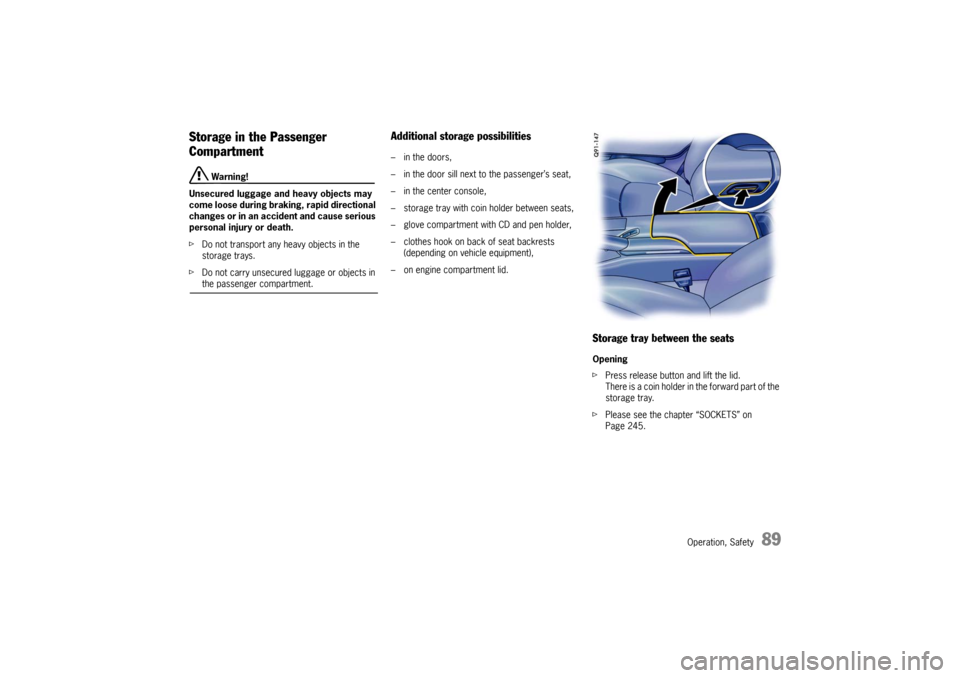
Operation, Safety
89
Storage in the Passenger
Compartment
Warning!
Unsecured luggage and heavy objects may
come loose during brak ing, rapid directional
changes or in an accident and cause serious
personal injury or death.
f Do not transport any heavy objects in the
storage trays.
f Do not carry unsecured luggage or objects in the passenger compartment.
Additional storage possibilities – in the doors,
– in the door sill next to the passenger’s seat,
– in the center console,
– storage tray with coin holder between seats,
– glove compartment with CD and pen holder,
– clothes hook on back of seat backrests (depending on vehicle equipment),
– on engine compartment lid.
Storage tray between the seatsOpening
f Press release button and lift the lid.
There is a coin holder in the forward part of the
storage tray.
f Please see the chapter “SOCKETS” on
Page 245.
Page 92 of 294
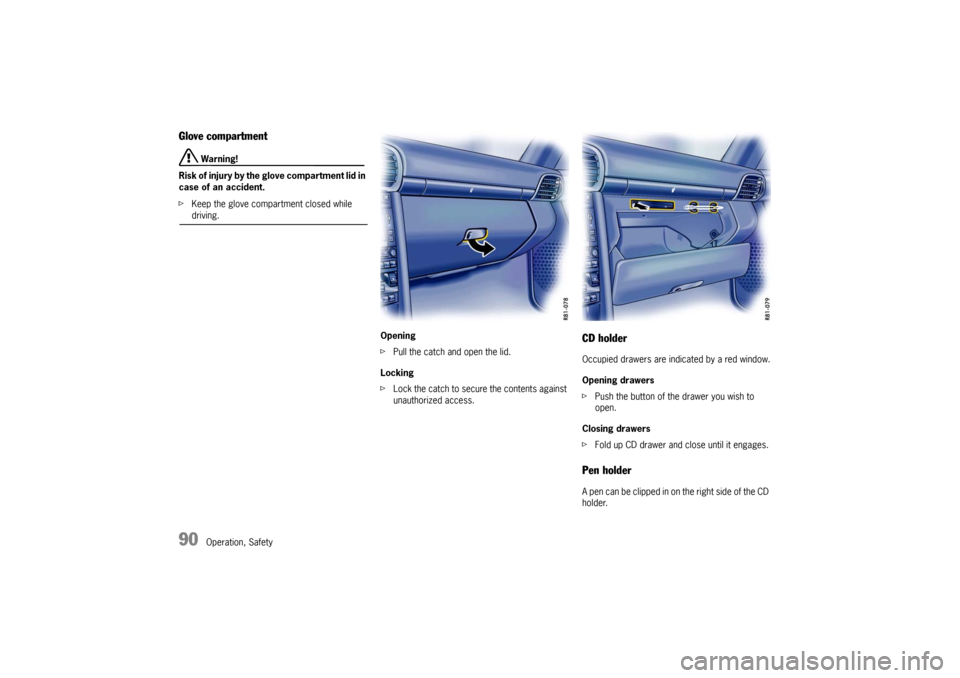
90
Operation, Safety
Glove compartment
Warning!
Risk of injury by the glove compartment lid in
case of an accident.
f Keep the glove compartment closed while driving.
Opening
fPull the catch and open the lid.
Locking
f Lock the catch to secure the contents against
unauthorized access.
CD holderOccupied drawers are indicated by a red window.
Opening drawers
fPush the button of the drawer you wish to
open.
Closing drawers
f Fold up CD drawer and close until it engages.Pen holderA pen can be clipped in on the right side of the CD
holder.
Page 93 of 294
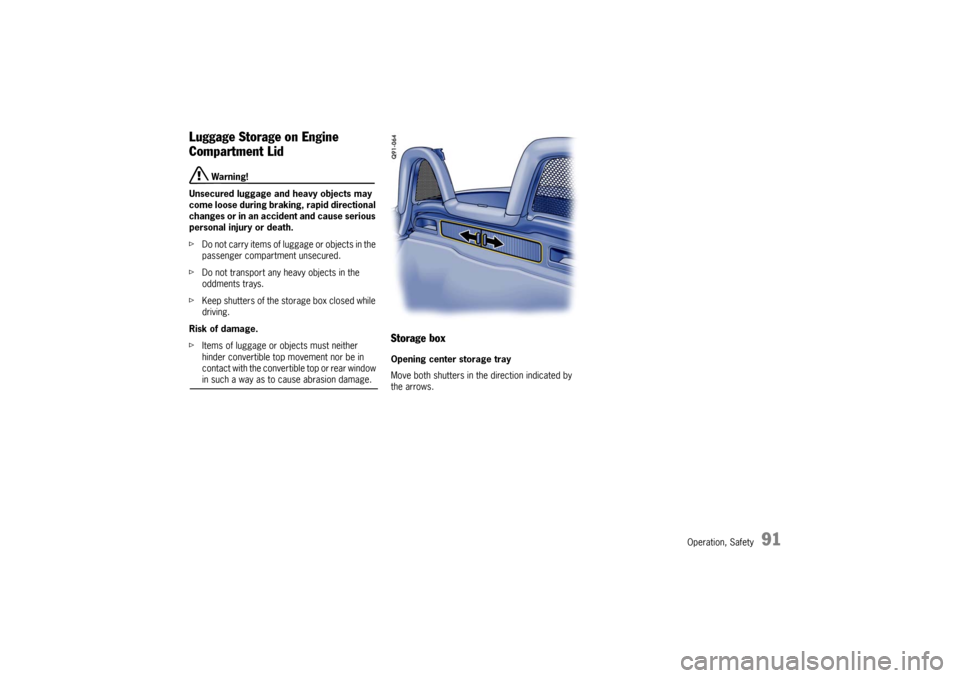
Operation, Safety
91
Luggage Storage on Engine
Compartment Lid
Warning!
Unsecured luggage and heavy objects may
come loose during brak ing, rapid directional
changes or in an accident and cause serious
personal injury or death.
f Do not carry items of luggage or objects in the
passenger compartment unsecured.
f Do not transport any heavy objects in the
oddments trays.
f Keep shutters of the storage box closed while
driving.
Risk of damage.
f Items of luggage or objects must neither
hinder convertible top movement nor be in
contact with the convertible top or rear window in such a way as to cause abrasion damage.
Storage box Opening center storage tray
Move both shutters in the direction indicated by
the arrows.
Page 94 of 294
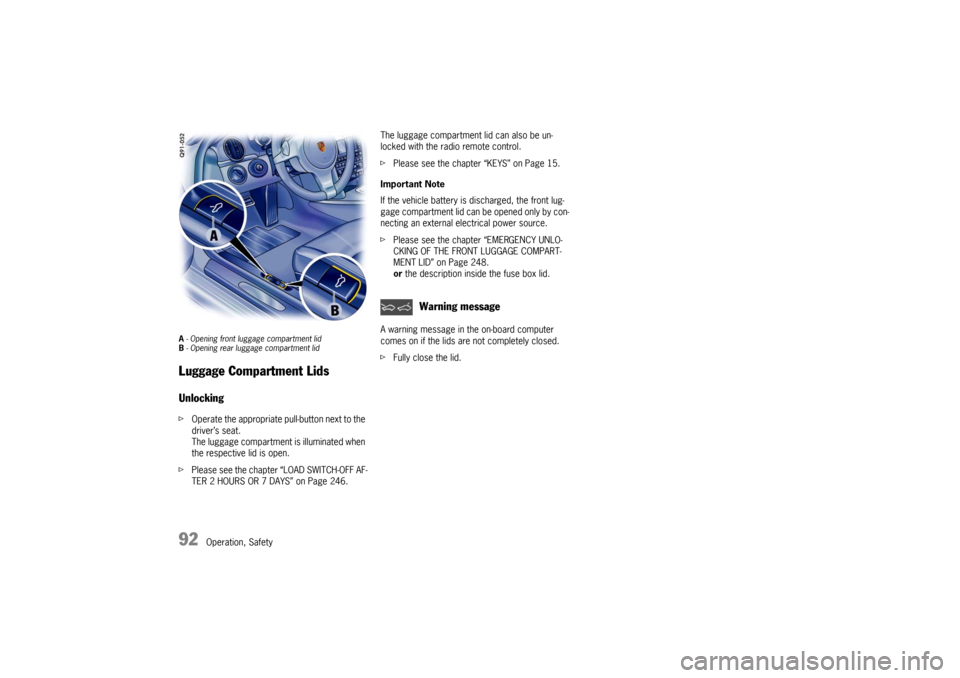
92
Operation, Safety
A - Opening front lugga ge compartment lid
B - Opening rear luggage compartment lid Luggage Compartment LidsUnlocking f Operate the appropriate pull-button next to the
driver’s seat.
The luggage compartment is illuminated when
the respective lid is open.
f Please see the chapter “LOAD SWITCH-OFF AF-
TER 2 HOURS OR 7 DAYS” on Page 246. The luggage compartment lid can also be un-
locked with the radio remote control.
f
Please see the chapter “KEYS” on Page 15.
Important Note
If the vehicle battery is discharged, the front lug-
gage compartment lid can be opened only by con-
necting an external electrical power source.
f Please see the chapter “EMERGENCY UNLO-
CKING OF THE FRONT LUGGAGE COMPART-
MENT LID” on Page 248.
or the description inside the fuse box lid.
A warning message in the on-board computer
comes on if the lids are not completely closed.
f Fully close the lid.
Warning message
Page 95 of 294
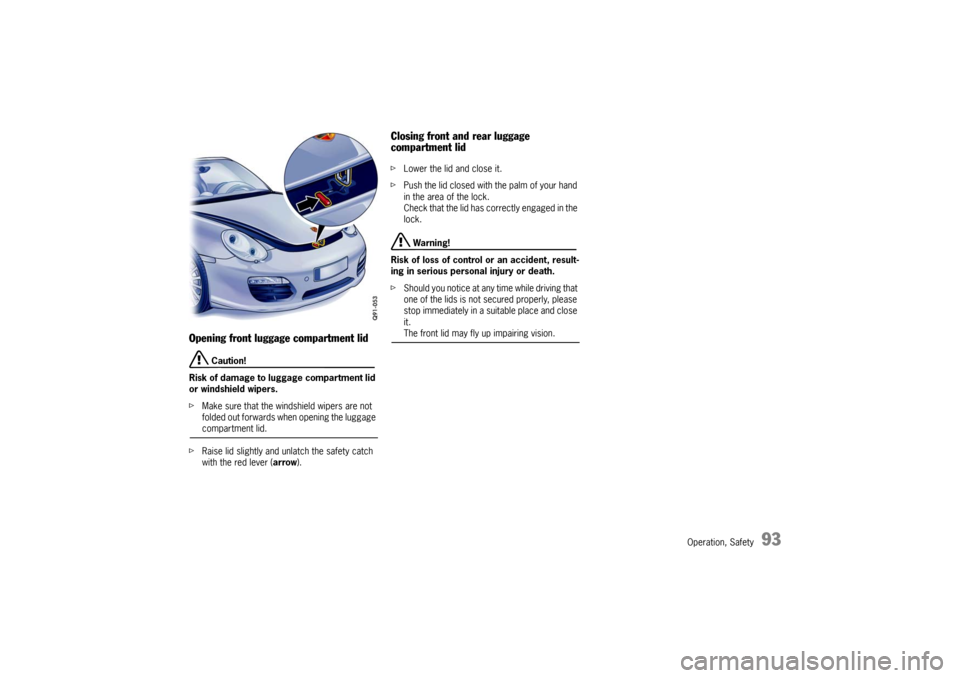
Operation, Safety
93
Opening front luggage compartment lid
Caution!
Risk of damage to luggage compartment lid
or windshield wipers.
f Make sure that the windshield wipers are not
folded out forwards when opening the luggage compartment lid.
f Raise lid slightly and unl atch the safety catch
with the red lever ( arrow).
Closing front and rear luggage
compartment lid fLower the lid and close it.
f Push the lid closed with the palm of your hand
in the area of the lock.
Check that the lid has correctly engaged in the
lock.
Warning!
Risk of loss of control or an accident, result-
ing in serious personal injury or death.
f Should you notice at any time while driving that
one of the lids is not secured properly, please
stop immediately in a suitable place and close
it. The front lid may fly up impairing vision.
Page 96 of 294
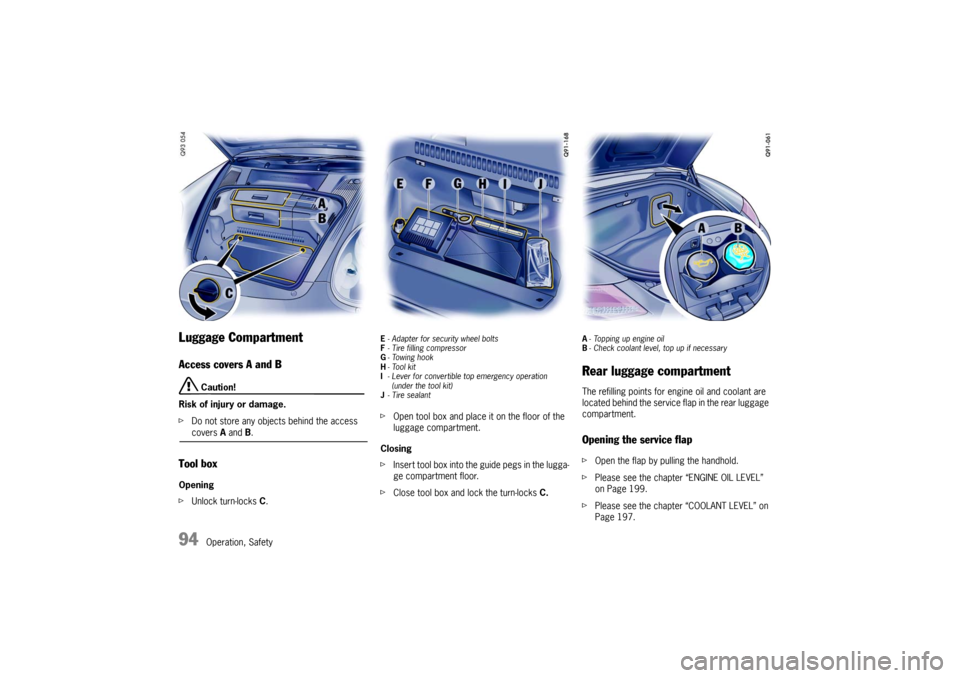
94
Operation, Safety
Luggage Compartment Access covers A and B
Caution!
Risk of injury or damage.
f Do not store any objects behind the access covers A and B.
Tool boxOpening
f Unlock turn-locks C.
E- Adapter for security wheel bolts
F - Tire filling compressor
G -Towing hook
H -Tool kit
I - Lever for convertible top emergency operation
(under the tool kit)
J -Tire sealantf Open tool box and place it on the floor of the
luggage compartment.
Closing
f Insert tool box into the guide pegs in the lugga-
ge compartment floor.
f Close tool box and lock the turn-locks C.
A-To p p i n g u p e n g i n e o i l
B -Check coolant level, top up if necessaryRear luggage compartmentThe refilling points for engine oil and coolant are
located behind the service flap in the rear luggage
compartment.Opening the service flapf Open the flap by pulling the handhold.
f Please see the chapter “ENGINE OIL LEVEL”
on Page 199.
f Please see the chapter “COOLANT LEVEL” on
Page 197.
Page 97 of 294
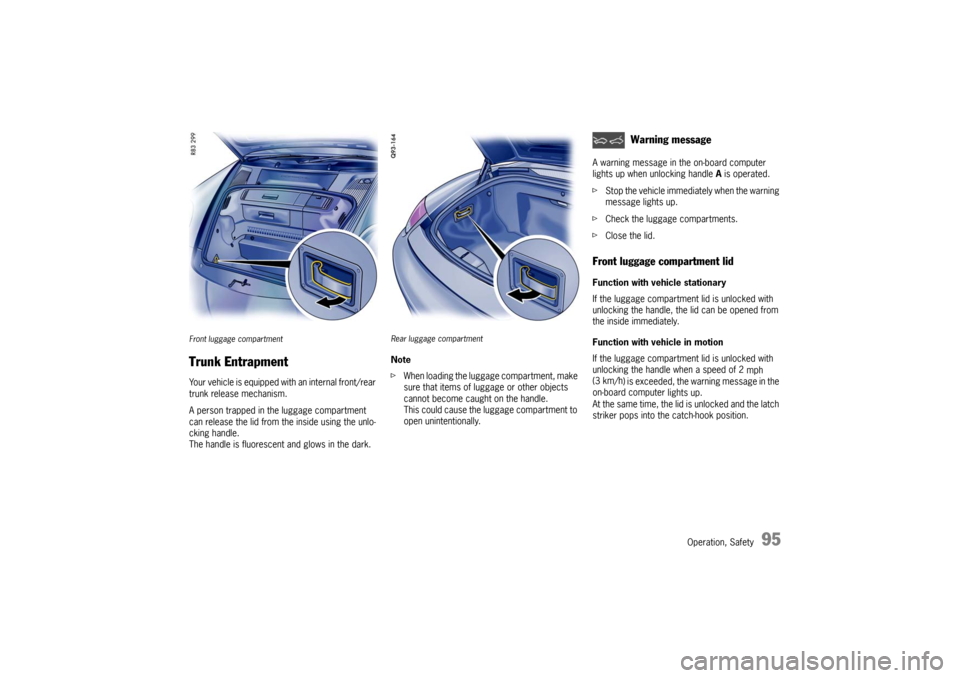
Operation, Safety
95
Front luggage compartment Trunk Entrapment Your vehicle is equipped with an internal front/rear
trunk release mechanism.
A person trapped in the luggage compartment
can release the lid from the inside using the unlo-
cking handle.
The handle is fluorescent and glows in the dark.
Rear luggage compartment Note
fWhen loading the luggage compartment, make
sure that items of luggage or other objects
cannot become caught on the handle.
This could cause the luggage compartment to
open unintentionally. A warning message in the on-board computer
lights up when unlocking handle
A is operated.
f Stop the vehicle immediately when the warning
message lights up.
f Check the luggage compartments.
f Close the lid.
Front luggage compartment lid Function with vehicle stationary
If the luggage compartment lid is unlocked with
unlocking the handle, the lid can be opened from
the inside immediately.
Function with vehicle in motion
If the luggage compartment lid is unlocked with
unlocking the handle when a speed of 2 mph
(3 km/h ) is exceeded, the warning message in the
on-board computer lights up.
At the same time, the lid is unlocked and the latch
striker pops into the catch-hook position.
Warning message
Page 98 of 294

96
Operation, Safety Danger!
Risk of accident.
If the warning message in the on-board com-
puter lights up when the vehicle is in motion,
the lid may impact in fr ont of the windshield
and can tear off.
You can lose control of the vehicle, and
serious personal injury or death may result.
f Stop the vehicle immediately when the warning
message lights up.
f Check the luggage compartment.
fClose the lid.Rear luggage compartment lid If the rear luggage compartment lid is unlocked
with unlocking the handle , the lid opens immedia-
tely.
f Stop the vehicle immediately when the warning
message lights up.
f Check the luggage compartment.
f Close the lid. Note
The front lid cannot be opened from the inside if
the battery is disconnected or empty.
Safety reasons therefore require that you
unscrew the latch striker of the front lid lock
if you plan to put the vehicle out of operation
for an extended period.
f
Please consult your authorized Porsche
dealer.
They will advise you about the necessary
measures.
Page 99 of 294

Operation, Safety
97
Porsche Communication
Management (PCM) fRefer to the separate operating instructions
before putting the PCM into operation.
f Please see the chapter “LOAD SWITCH-OFF
AFTER 2 HOURS OR 7 DAYS” on Page 246.
Warning!
There is a danger of accident if you set or
operate the on-board computer, radio, navi-
gation system, telephone or other equipment
when driving.
This could distract you from the traffic and
cause you to lose control of the vehicle re-
sulting in serious personal injury or death.
f Operate the components while driving only if
the traffic situation allows you to do so safely.
f Carry out any complicated operating or setting procedures only with the vehicle stationary.
The reception conditions for the radio module
integrated in the PCM ch ange continuously as you
drive. Interference from buildings, terrain and the
weather is unavoidable.
FM stereo reception is particularly susceptible to
varying reception conditions.
Electronic accessories should only be retrofitted
by your authorized Porsche dealer. Accessories which have not been tested and
approved by Porsche may impair radio function
and reception.
NavigationWhen put into operation for the first time, a
distance of approx. 30 miles (50 km) must be
driven in order for the navigation system to
complete the process of fine calibration.
The same applies when the tires are changed (e.g.
summer/snow tires) or new tires fitted.
Full location accuracy is not yet achieved during
the fine-calibration process.
If the vehicle has been transported (e.g. ferry, car
train), the system may take a few minutes to deter-
mine the current locati
on after it has been
switched on.
Serious tire slip (e.g. spinning wheels on snow)
may result in temporaril y inaccurate navigation.
When the battery has been disconnected, it may
take up to 15 minutes before the navigation
system is operational again.
Car Audio Operation/Tips For radio operation see your radio manual
which is included with your on-board litera-
ture.
f Please see the chapter “LOAD SWITCH-OFF AF-
TER 2 HOURS OR 7 DAYS” on Page 246.
FM reception
A vehicle is not an ideal pl ace to listen to a radio.
Because the vehicle moves, reception conditions
are constantly changing.
Buildings, terrain, signal distance and noise from
other vehicles are all working against good recep-
tion.
Some conditions affecting FM may appear to be
problems when they are not.
The following characteristics are completely nor-
mal for a given reception area, and they do not in-
dicate any problem with the radio itself.
Note
Electronic accessories shou ld only be installed by
your authorized Porsche dealer.
Equipment which has not been tested and ap-
proved by Porsche may impair radio reception.
Page 100 of 294

98
Operation, Safety
Fading and drifting
FM range is limited to
about 25 miles (40 km),
except for some high power stations.
If a vehicle is moving aw ay from the desired sta-
tion’s transmitter, the signal will tend to fade and/
or drift. This condition is more prevalent with FM
than AM, and is often ac companied by distortion.
Fading and drifting can be minimized to a certain
degree by careful attention to fine tuning or selec-
tion of a stronger signal.
Static and fluttering
When the line-of-sight link between a transmitter
and vehicle is blocked by large buildings or moun-
tains, the radio sound may be accompanied with
static or fluttering because of the characteristic of
FM.
In a similar effect, a fluttering noise is sometimes
heard when driving along a tree-lined road.
This static and fluttering can be reduced by adjust-
ing the tone control for greater bass response un-
til the disturbance has passed.
Multipath
Because of the reflecting characteristics of FM,
direct and reflected signals may reach the antenna
at the same time (multipath) and cancel each other
out.
As a vehicle moves through these electronic dead
spots, the listener may hear a momentary flutter
or loss of reception. Station swapping
When two FM stations are close to each other, and
an electronic dead spot, such as static or multi-
path area, interrupts the original signal, some-
times the stronger second signal will be selected
automatically until the original one returns.
This swapping can also occur as you drive away
from the selected station and approach another
station of a stronger signal.
Compact disc player
Caution!
To avoid damage to compact disc player and
discs.
f Use only compact discs labeled as shown, hav-
ing no dirt, damage or warpage.
f Never attempt to disassemble or oil any part
of the player unit.
Do not insert any object other than a disc into
the slot.
Remember there are no user-serviceable parts
inside the compact disc player.
f Do not allow the disc to sustain any finger-
prints, scrapes or stickers on the surfaces.
This may cause poor sound quality.
Hold the disc only on the edge or center hole. f
When not in use, take th e disc out of the player,
put the disc back into its case and store it
away from dust, heat, damp and direct
sunlight.
Leaving the disc on the dashboard in the sun
can damage the disc.
f If the disc gets dirty, clean the disc by wiping
the surfaces from the center to the outside in
a radial direction with a soft cloth.
Do not use a conventional record cleaner or
anti-static record preservative.
Disc cleaners are available in audio stores.